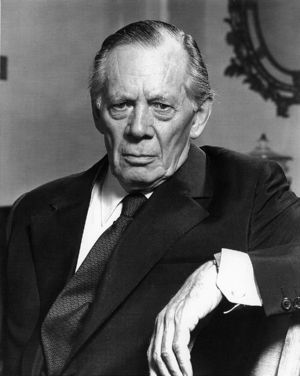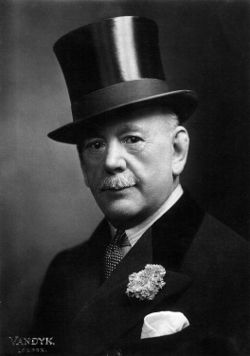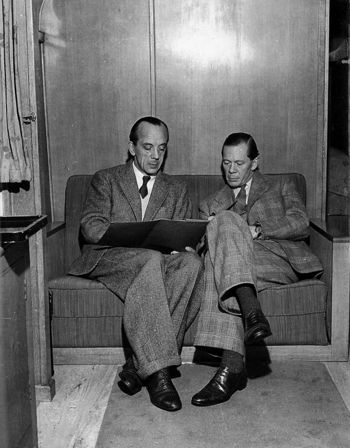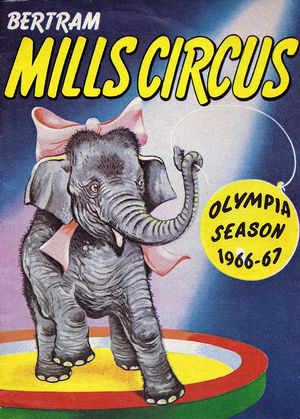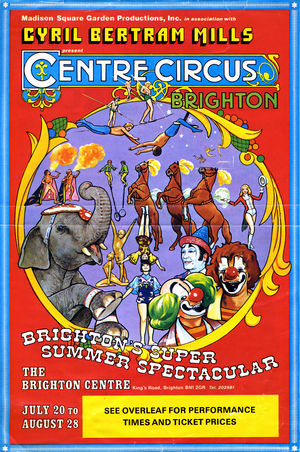Cyril Mills
From Circopedia
Circus Owner and Director
By Don Stacey
Editor’s Note: Don Stacey joined the Bertram Mills Circus as a teenager, and worked there for five years in the Press Department, with a break for National Service in the Royal Air Force. After the Bertram Mills Circus closed down in 1967, he and Cyril Mills remained close friends.
The Bertram Mills Circus was started by Bertram Wagstaff Mills, a former RASC Captain in the First World War, who was a coach builder, an international horseshow judge, and ran a very successful undertaker’s business in London. As the story goes, Mills, who had many influential friends in high places, attended a performance of the Great Victory Circus and Allied Fair at the Olympia exhibition hall in London during the 1919/1920 winter season; when pressed for his opinion of the show, he is recorded as having said, "If I could not give the people a better circus than that for their money, I’d eat my hat!"
A wager was promptly placed, and one can imagine the scene at Mills’ home on the February evening of 1920, when Bertram Mills revealed to his startled wife, Ethel, and his teenage sons, Cyril and Bernard, than he intended to run a big circus at Olympia the following winter, plunging at forty-five into a business of which he had little knowledge. His wife protested, "But Bertram, you’ll lose what little money we’ve got! What on earth do you know about circuses?"
Mills went on to win his bet in splendid style and as Cyril recollected: "Mother was saved from bankruptcy, and though we were both still schoolboys, [Bernard and I] recalled that—well, something pretty stupendous had started in our lives." And the rest, as they said, is Circus History!
From Engineering To Circus Management
Cyril Bertram Mills was born on February 27, 1902, the elder of two sons of the man who would be hailed as the "King of the Modern Circus." Cyril was educated at Harrow and Cambridge, becoming an M. A. in engineering, and worked as an engineer in the oil business from 1923 to 1925—including a spell in Rangoon, Burma. On two occasions in Burma, he survived large explosions; in one, he was soaked in burning oil, and survived only by rolling in the dirt to extinguish the flames.
When Bertram Mills started his first quest for circus talent on the continent (following the disappointing news that John Ringling couldn’t bring over from America The Greatest Show On Earth to fill Olympia as Mills had wanted), he invited his son Cyril to accompanying him—partly because of Cyril’s knowledge of foreign languages, but also to provide a teenager’s reaction to the acts they saw.
By the time Cyril returned to England in 1925 after his stint as an oil engineer in Burma, Bertram Mills had established a superlative circus, and Cyril accepted his father’s offer of a job in the circus industry—where he would spend the rest of his active life. Cyril first became assistant manager in a dance hall Mills ran at the Royal Opera House, Covent Garden (Bertram Mills also had the biggest dance hall in the world at the National Hall, Olympia), and by the winter of 1925/1926, he was assistant manager for the Christmas circus at Olympia—when his brother, Bernard Notley Mills, also joined the company as acting manager.
In actual fact, despite being involved in the oil industry, Cyril had assisted his father at Olympia each winter since 1922. In 1927, both Cyril and Bernard joined their father as directors of the circus company. Cyril’s first major assignment was to arrange the transportation from Paris to London of his father’s star attraction(Russian) A circus act that can occupy up to the entire second half of a circus performance. for the 1925/1926 season, the huge group of seventy lions of Captain Alfred Schneider—which created a sensation in the metropolis at that time.
From 1928 onwards, Cyril was booking acts for his father, and in 1933, he took over from the celebrated Willy Schumann as producer of the annual Christmas circus; the job would remain his for the rest of his career. Every year, therefore, Cyril Mills would embark on an extensive tour of Europe in search of new circus talent.
The Bertram Mills Circus Goes On Tour
In 1929, the Mills family entered into a partnership with the Australian illusionist and circus proprietor Harry Carmo (Cameron) to run a tenting circus, which toured under the title of The Great Carmo Circus. Cyril and Bernard travelled with it for one season, after which Mills and Carmo parted company. The Mills boys had learned a lot about running a major tenting outfit, and in 1930, they launched their own Bertram Mills Circus as a tenting show, which would tour the British provinces until 1964.Although Bertram Mills was indeed willing to help his sons and finance the tenting circus (there was not enough work to keep the three of them busy just organising the Christmas circus), he did not wish to travel with it and, from its inception, the Mills tenting show was run by Cyril and Bernard—with the proviso that it would be run according to the high standards Bertram Mills had established at Olympia. As Cyril Mills told this writer, "Our purpose was to give the public a good circus—something the provinces had not seen for a long time, if ever. I do not think Sanger or anyone else had ever tempted to produce an international programme of quality, and our intention was to take a small version of Olympia to the provinces."
Copying the best of the great German circuses of the time—Sarrasani, Krone and Hagenbeck, which were leading the European travelling circus industry—Bertram Mills Circus became a model of modern tenting standards in Britain. The brothers ran it until 1964, when declining profits brought it to a sad end. They were forced to put it into storage in 1939, when the Second World War broke out, and apart from a short-lived and trouble-wracked stage tour in 1940, the circus was not revived until 1946, when the war ended.
Although the Mills brothers started their tenting circus during the century’s worst period of depression, it was to become one of the most famous in Europe, and Britain’s largest—until this title was eventually overtaken in post-war years by the rising family show of Chipperfield and the new Billy Smart’s Circus.
The Flying Director
But the story is racing ahead! Back in 1933, by which time the Bertram Mills’ tenting show was established as Britain’s finest, Cyril Mills found himself one day in a crowded tent, confronted by three tigers: Three of Togare’s tigers escaped the big cage during a performance at Davenport. Fortunately, Mills and some circus staff were able to round up the animals before anyone was injured. In the same season, fire struck at Gloucester and he averted disaster by directing a fireman to drench the big topThe circus tent. America: The main tent of a traveling circus, where the show is performed, as opposed to the other tops. (French, Russian: Chapiteau) with water before the flames could reach it. Cyril Mills had become a true circus man.
That same year, in 1933, Cyril obtained a private pilot’s licence and purchased the first of his three aircrafts, which he flew until 1951. During these years, he did most of his talent-spotting by air, often flying up to 35,000 miles a year in search of acts. He became the first circus proprietor to travel around Europe seeking acts under his own power. (In post-war years, Ronnie Smart, of Billy Smart’s Circus, copied his exploits.)
Among the spectacular acts he discovered for the circus over the years were Koringa, who "hypnotised" crocodiles and had herself buried alive; Rudi Horn, a young German who tossed cups and saucers from the tip of his foot to his head while balancing on a unicycle; Little John (John Seidel), the twelve-year-old Danish Boy-Wonder equilibrist; Con Colleano, the world’s greatest wirewalker; Borra, "The King of Pickpockets;" American clown Emmett Kelly; the Flying Gaonas; and the Japanese cycling star Lilly Yokoi.
In post-war years, audiences came to love the regular visits of Europe’s greatest horsemen, the Knies and the Schumanns; great animal trainers like Togare, Vojtek Trubka, Gerd Siemoneit, and Eugen Weidman; and bareback riding stars like the Cumberlands, and the Carolis—who were also the inimitable clowns, The Francescos.
His programs were not, however, without occasional failures, and in 1964, a last-ditch attempt to modernise the circus—a move he opposed but which his brother, Bernard, and the other co-directors approved—by booking a pop group, the Barron Knights, who did impersonations of other famous pop groups of the time, was the biggest mistake to which he later admitted.
Probably, the most unusual attractions he introduced were sideshow curiosities like the Royal Padaung Giraffe-Neck Women from Upper Burma in 1934; Ohmi, the Tattooed Man with the Ostrich Digestion; and Gargantua, Ringling Bros. and Barnum & Bailey’s star gorilla—attractions that were then considered acceptable in the fun fair that accompanied the circus at Olympia.
Cyril and Bernard Mills Ltd.
Cyril and Bernard Mills’ father, Bertram Mills, died in 1938, on the day of the Bertram Mills Circus’ season premiere; as tradition dictates, "The show must go on," and so it did. Then Cyril and Bernard took over the running of the company, forming with their mother, Ethel, Cyril and Bernard Mills Ltd. The brothers worked well together, each having his own function in the company. Cyril concentrated on the technical aspect and the booking of the programme and its artistic content. Bernard was in charge of the company’s animal acts and trainers, and of the administrative side of the business—although they could both complement the abilities of the other.Bernard Notley Mills was born on May 10, 1905, and like his brother, was educated at Harrow and Cambridge before entering his father’s circus business in 1925. Tall, slim and always immaculately dressed, he had inherited from his father his sound horse sense and tailored perfection. A member of the Coaching Club, he was a notable horseman and judge at leading horseshows, as had been his father, in both Europe and the United States. He bought all the fine horses owned by the Mills Circus over the years, and engaged all the "house" trainers for the Mills animal acts.
While Bernard Mills might be described as urban, suave and outwardly cool, he could harbour resentment and dislike. His brother, Cyril, was altogether more outgoing, equally gregarious, but more volatile in nature, dogmatic and often pig-headed. He could explode with temper one moment and quickly forget the cause of his anger the next, and he never bore a grudge.
The original template Bertram Mills produced for his winter seasons at Olympia in London and for the tenting show, which was organized with military precision, remained inviolate with Cyril and Bernard Mills until the circus closed in 1967. Contemplating change was something the directors of Bertram Mills Circus seemed steadfastly against and vehemently opposed to, any more than they would have thought of reducing the size or quality of their product.
It is hard today to imagine the awe and respect in which the brothers held their celebrated father, who had become the King of the Circus World in Great Britain. On one occasion in January of 1983, at the annual Circus Reunion, Cyril Mills was overcome with emotion on seeing a film of his father’s funeral forty five years earlier. In tears, he sobbed to me, "He really was a great man, you know." Ethel Mills’ death in June 1960, at age eighty-six, brought from both sons simply a sigh: They heard the news while working at the organisation of the all-important Opening Luncheon for the following winter season at Olympia, and promptly returned to the work at hand.
The War Years And After
His pilot licence would indirectly catapult Cyril Mills into the world of espionage; in 1936, during one of his many flights over Germany in his De Havilland Hornet Moth, Mills was drawn into the build-up of World War II. As he studied the ground below, he spotted a railway disappearing into remote mountains, and to his engineer’s eye, this suggested a covert military factory. Aware that the British Government was becoming alarmed at the growth of Germany’s military might, Mills duly passed on this information to the British Security Services, MI5, and he was asked to watch out for suspicious sites during his air travels.
He continued to aid the security forces until the war broke out, at which point he was recruited into the Security Service and resumed his spying exploits, guiding work for the celebrated double agent Garbo (Joan Pujol Garcia), forging links with United States security agencies, and moving to Canada, where he became MI5’s (Secret Services) representative there. His brother, Bernard, served with the Royal Air Force.
During that time, the circus had been mothballed. It reopened triumphantly for the 1946 season, and the Christmas circus at Olympia was resumed in the winter of 1946/1947. In 1947, Cyril, with the aid of friends in the City, launched Bertram Mills Circus as a public company, with a quotation on the London Stock Exchange—the first circus in the world with such a quotation. Cyril and Bernard Mills remained joint Managing Directors of both the tenting show and the Olympia circus.
Profits in the early post-war years were very high, but by 1964, the tenting circus was running at a loss. A decision had to be made by the brothers, who had a responsibility toward their stockholders: They close the show at the end of that season, while retaining the annual Christmas circus in London.
The Final Years
For a short while, Cyril and Bernard Mills made a stab at the cinema business with Interama, a Cinerama show under a big topThe circus tent. America: The main tent of a traveling circus, where the show is performed, as opposed to the other tops. (French, Russian: Chapiteau) especially constructed for touring this form of entertainment. It failed eventually. An earlier chance to stage the Moscow Circus for the first time in England in 1956 was decisively turned down by Cyril Mills, his fiery anti-communist views overcoming his business instincts.Rising costs, dwindling profits, and the relentlessly increasing hold of television on the entertainment world were the downfall of the Mills show. Deeply loyal to the memory of their beloved father, Cyril and Bernard Mills had continued the show in the style and standards he had created, and were totally unwilling to concede to new ideas or accept a lowering of the template standards. Yet, in the early post-war period, the show was being challenged by new rivals: Tom Arnold and Clem Butson at the Harringay Arena in London at Christmas, and the Chipperfields and the Smarts with their more brash, colourful and appealing shows, both with hordes of animals, in the provinces.
In 1937, Mills had been the first circus in the world to be televised, but after the war, they had to call a halt to allowing it on television, Cyril saying, "I find hard to believe that you can sell something you are giving away." His ban on televising the show was short-lived, however, for financial reasons, and he capitulated—thus hastening the end of the Bertram Mills Circus.
The business of running a big circus had many problems, but some of them were new to the owners who came from an earlier environment and could not cope with a changing world. Declining business, and the upcoming end of their lease at Olympia, led to Cyril and Bernard Mills’ decision that the 1965/1966 Christmas season would be the last one for the circus at what had been its home since 1920. Cyril Mills ensured that, for what he thought was the final show, his programme was of superb quality; he wanted to go out on a high, never having let down the title of "The Quality Show" the Bertram Mills Circus had earned.
As it happened, instead of having to go into voluntary liquidation, the circus was temporarily saved by the catering and hotel magnate, Maxwell Joseph, who took it over for one final season, 1966/1967, at Olympia—before the lease expired for good. Cyril Mills resigned, but Bernard Mills remained with Joseph as Managing Director. The shortened season resulted in a loss, and thereafter, Bernard Mills and Maxwell Joseph were unable to find another suitable site for the circus in London. It was never resurrected.
Life After The Bertram Mills Circus
Cyril Mills had retired in 1966 to his sumptuous home in Cumberland Terrace, London, with his second wife, Mimi Meredith, a Canadian, whom he had married in 1950. Her son by her first marriage, Frederick Meredith, had been Cyril’s assistant during the last decade or so of the touring circus. Cyril had two children from a previous marriage, and he and Mimi had a son and a daughter together. Their son Christopher became a very successful financier in the City, seating on the boards of several investment trusts and other banking and finance groups. In retirement, Cyril was guided by Christopher in his investments and confided that from these, he made far more money than he ever made with the circus.In 1967, Cyril Mills wrote a book, Bertram Mills Circus — Its Story, which was reprinted in 1983 in paperback. He was also the subject of the popular television show This Is Your Life in January 1989, and in October 1990, appeared again on This Is Your Life, this time honouring his former ringmaster(American, English) The name given today to the old position of Equestrian Director, and by extension, to the presenter of the show., Norman Barrett. Probably the highlight of Cyril Mills’ career came on December 18, 1952, when Her Majesty the Queen attended a charity performance at the Bertram Mills Circus at Olympia in London. It was the first occasion on which a reigning monarch made an official visit to a public performance of a circus in Great Britain. Queen Elizabeth II eventually honoured the Bertram Mills Circus on twelve different occasions.
Once retired and having written the history of the Mills Circus as he saw it, Cyril Mills continued to show a great interest in the circus world, and despite suffering greatly from emphysema in his declining years, he would continue to visit the most important continental and British circuses every year, meeting up with old friends among the leading circus proprietors of the age.
In 1978, while working as Personnel and Publicity Director for the ice show Holiday On Ice and Madison Square Garden Productions, Inc., I was asked to stage and produce a big and spectacular circus at Brighton Centre, a new venue in Southern England. Holiday On Ice’s President, Skee Goodhart, instructed me to ask my old friend and former employer, Cyril Bertram Mills, to add his name to the show’s title, thinking this would ensure our success.
I was opposed to the idea, since the Mills title had been out of the public eye for over a decade, but Cyril’s cooperation was nonetheless enlisted at huge expense. Cyril entered into the project with an enthusiasm one might have not expected for a man approaching the age of eighty. He fully believed that the Bertram Mills name would still draw the public, and that the London theatre ticket agents, who had sold so many tickets in the Olympia heydays, would be able to fill the 4,000 seats of this new arena.
But Mills’ optimism was proved sadly wrong. Although I had assembled the best and most expensive programme ever seen outside of London, a decade had passed and with it, the golden era of the circus, when Cyril had been King. The names of Chipperfield and Smart had long usurped those of Mills and Sanger, and a bright newcomer named Gerry Cottle had already appeared on the scene. It proved to be Cyril Mills’ last association with the circus, and the last time the Bertram Mills name appeared in Britain.
Epilogue
After his father’s death, Cyril Mills had guarded with an obsessive zeal the traditions Bertram Mills had created—although this, to some extent, was to accelerate the demise of the show. In later life, still zealously guarding his heritage, he took steps to protect the title of Bertram Mills Circus against anyone who might be tempted to pirate it in Britain or elsewhere, and he applied to the Registrar of Joint Stock Companies to change the name of his private company to Bertram Mills Circus Ltd. To the day of his death, Cyril owned 98% of the share capital, the balance being held by members of his family.
For many years after his retirement, Cyril Mills was Honorary Chairman of the Association of Circus Proprietors of Great Britain. Cyril’s brother, Bernard, died at his home in London on January 27, 1985, after a long illness borne with great courage. Cyril followed him on July 20, 1991, at the age of eighty-nine. When he had appeared on television on BBC's This Is Your Life two years earlier, fifteen grandchildren had turned up for the show.
It is strange that, with all their many friends in high circles, and despite the fact that their circus entertained the greatest names in politics, the arts and, of course, Royalty, Bertram Mills and his sons, Cyril and Bernard, never achieved any high honour or recognition in their country in respect to their contribution to the world of entertainment. Cyril Bertram Mills outlived his greatest rivals in the circus industry—Billy Smart, Dick and Jimmy Chipperfield, Tom Arnold and Clem Butson—and with his death, the golden era of the British circus came to an end.
See Also
- Circuses: Bertram Mills Circus
- Biography: Bertram Mills
Suggested Reading
- A. Stanley Williamson, On The Road With Bertram Mills (London, Chatto & Windus, 1937)
- Robert Aylwin, The Bertram Mills Book Of The Circus (London, Naldrett, 1954)
- Cyril Bertram Mills, Bertram Mills Circus — Its Story (London, Hutchinson, 1967; paperback reprint published by Ashgrove Press, Bath, in 1983) — ISBN 0-906798-22-1
- David Jamieson, Bertram Mills — The Circus That Travelled By Train (Little Hormead, Aardvark Publishing, 1998) — ISBN 1-872904-11-4
